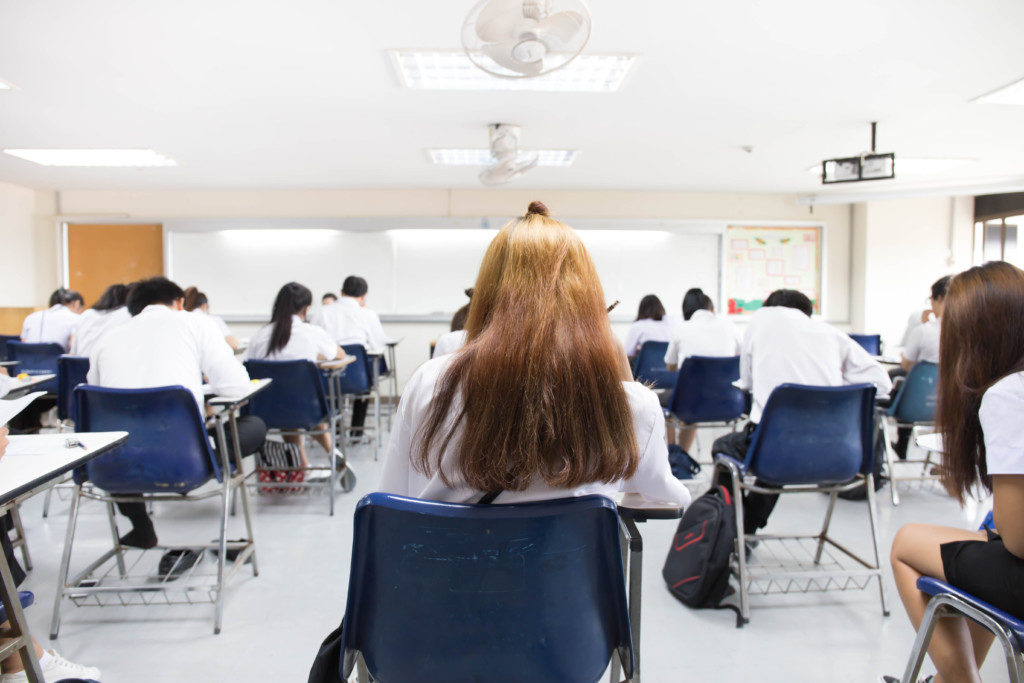 Results from the 2022 National Assessment of Educational Progress (NAEP) aren’t pretty, but Florida does have some bright spots. The state’s students continue to excel at reading, especially when viewing the results demographically, and in particular, by free and reduced-price lunch eligibility, an indicator of poverty.
Results from the 2022 National Assessment of Educational Progress (NAEP) aren’t pretty, but Florida does have some bright spots. The state’s students continue to excel at reading, especially when viewing the results demographically, and in particular, by free and reduced-price lunch eligibility, an indicator of poverty.
Comparing overall results isn’t entirely fair, since Florida is a majority-minority state, a term used to refer to a subdivision in which one or more racial, ethnic and/or religious minorities make up a majority of the population. Florida also has a larger than average low-income student population.
With that in mind, Florida’s fourth-grade Reading results continue to demonstrate that the Sunshine State punches above its weight, showing that the state’s efforts to improve education in elementary grades has paid dividends, allowing Florida to top the nation in NAEP rankings in those early grades no matter how you slice the data.
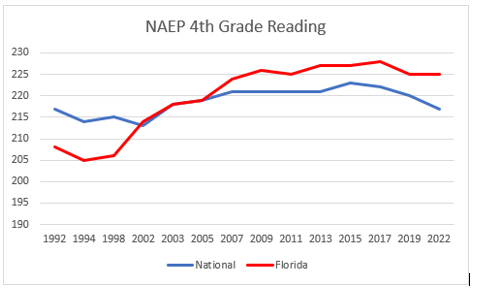 Florida’s low-income students had a modest decline during the COVID-19 pandemic, but that decline was much smaller than the 2017-19 decline. Nationally, low-income students suffered a far more severe decline in fourth-grade Reading outcomes to the point where Florida’s students are now a grade level ahead of their counterparts.
Florida’s low-income students had a modest decline during the COVID-19 pandemic, but that decline was much smaller than the 2017-19 decline. Nationally, low-income students suffered a far more severe decline in fourth-grade Reading outcomes to the point where Florida’s students are now a grade level ahead of their counterparts.
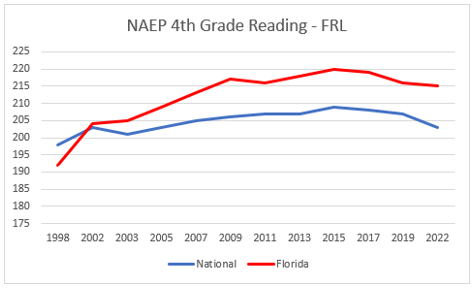 Florida’s fourth graders didn’t suffer as badly as the rest of the nation. White and Hispanic students in fourth grade bounced back from 2019 results, while Black students saw a decline that mirrored results of the rest of the nation.
Florida’s fourth graders didn’t suffer as badly as the rest of the nation. White and Hispanic students in fourth grade bounced back from 2019 results, while Black students saw a decline that mirrored results of the rest of the nation.
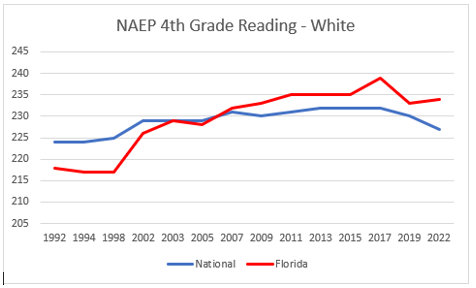
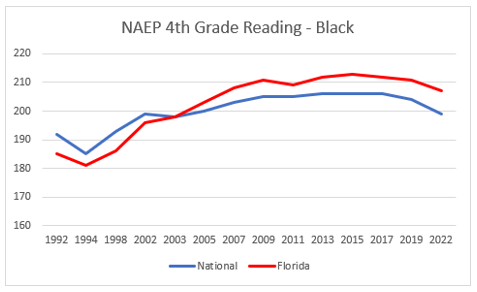
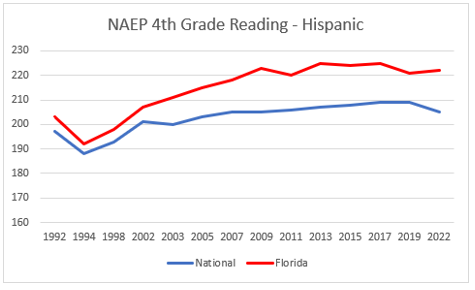
Florida’s fourth grade students are about a grade level ahead of students nationally. When adjusting for demographics and poverty, Florida ranks No. 1 in the nation for fourth grade Reading but drops to around eighth for eighth grade Reading. Without this adjustment for poverty and race, Florida’s eighth-grade Reading results appear to be just average.
Eighth grade Reading declines were sharp, but no worse than the national average. Remember, though, the national average is both whiter and wealthier than the average student in Florida.
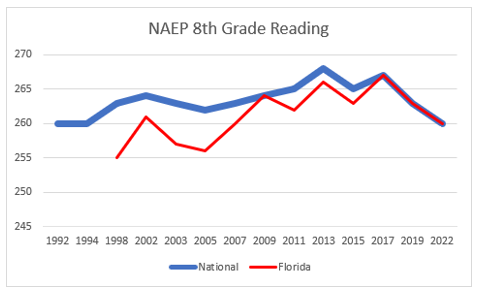 Low-income student performance declines mirrored the rest of the nation, but economically-disadvantaged children are still better off in Florida than in the vast majority of states.
Low-income student performance declines mirrored the rest of the nation, but economically-disadvantaged children are still better off in Florida than in the vast majority of states.
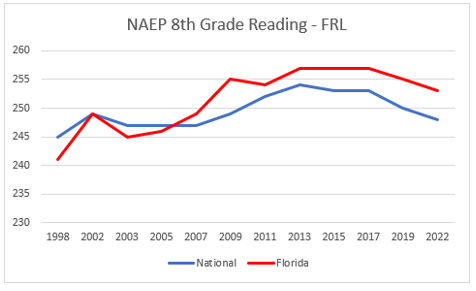 It’s impressive to see how big the drop was for Florida’s white eighth grade students between 2019 and 2022. Why this occurred is a mystery, but it is the driver behind Florida’s sharp (but entirely average) decline in eighth grade Reading results.
It’s impressive to see how big the drop was for Florida’s white eighth grade students between 2019 and 2022. Why this occurred is a mystery, but it is the driver behind Florida’s sharp (but entirely average) decline in eighth grade Reading results.
 Florida’s white students saw a staggering 8-point drop from 2019, while the national average was a 4-point drop. This was far more severe than the decline for Hispanic and Black students in Florida and nationally.
Florida’s white students saw a staggering 8-point drop from 2019, while the national average was a 4-point drop. This was far more severe than the decline for Hispanic and Black students in Florida and nationally.
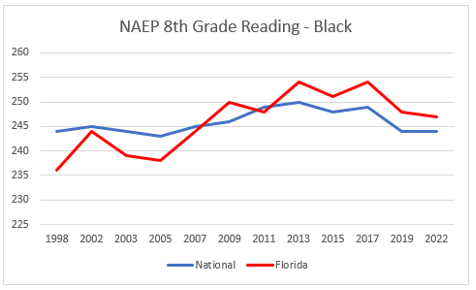 Both Black and Hispanic students continue to beat the national average on eighth grade Reading results.
Both Black and Hispanic students continue to beat the national average on eighth grade Reading results.
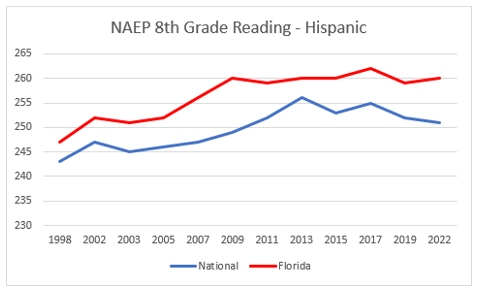 One final point: everything learned in fourth grade is a building block for later grades. Florida’s students don’t peak in fourth grade just because the state’s results top the charts. Florida’s fourth graders are, on average, a grade level ahead of their counterparts nationally.
One final point: everything learned in fourth grade is a building block for later grades. Florida’s students don’t peak in fourth grade just because the state’s results top the charts. Florida’s fourth graders are, on average, a grade level ahead of their counterparts nationally.
Without those early big gains in fourth grade, Florida’s eighth grade results would be much worse than “just average.” (And again, that “average” is compared to all incomes and races nationally, despite Florida’s status as a majority-minority state with a larger than average population of students who qualify for free or reduced-price lunch.)
Florida’s students are still getting about a year’s worth of learning in a year’s time between fourth and eighth grades. On average, Florida students gained 35 points in four years, a roughly 3.5 grade level growth.
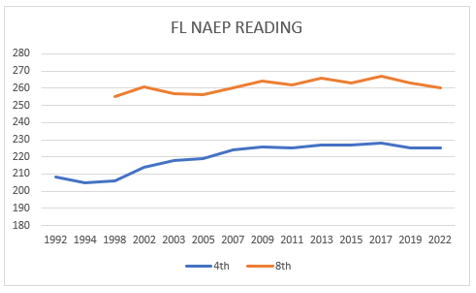 Low-income students gained 38 points between fourth and eighth grades, roughly four years’ worth of learning in four years’ time.
Low-income students gained 38 points between fourth and eighth grades, roughly four years’ worth of learning in four years’ time.
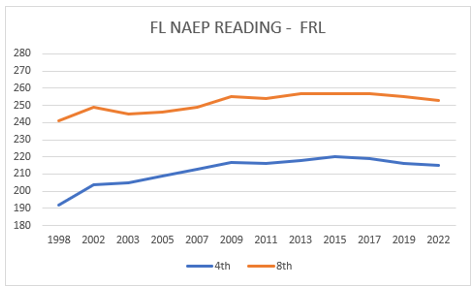 Florida’s white students are driving underperformance by eighth grade, gaining just 31 points between fourth and eighth grades, which is about three years of learning in four years’ time.
Florida’s white students are driving underperformance by eighth grade, gaining just 31 points between fourth and eighth grades, which is about three years of learning in four years’ time.
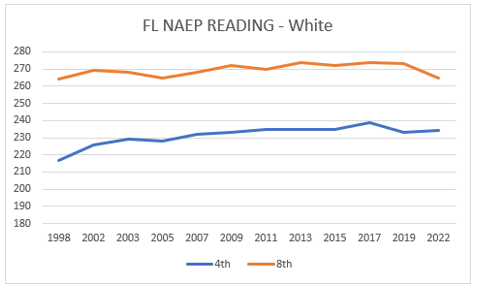 Florida’s Black students gained 40 points between fourth and eighth grades, meaning they gained a grade level of learning for each grade completed.
Florida’s Black students gained 40 points between fourth and eighth grades, meaning they gained a grade level of learning for each grade completed.
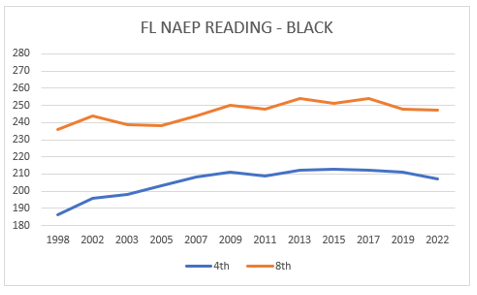 Meanwhile, Florida’s Hispanic students gained 38 points in four years, roughly a year’s worth of learning in a year’s time for each grade.
Meanwhile, Florida’s Hispanic students gained 38 points in four years, roughly a year’s worth of learning in a year’s time for each grade.
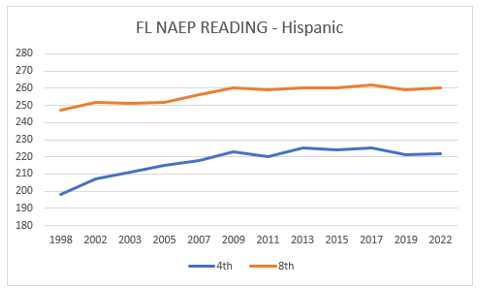 Coming up next week: the breakdown of the NAEP Math results.
Coming up next week: the breakdown of the NAEP Math results.


